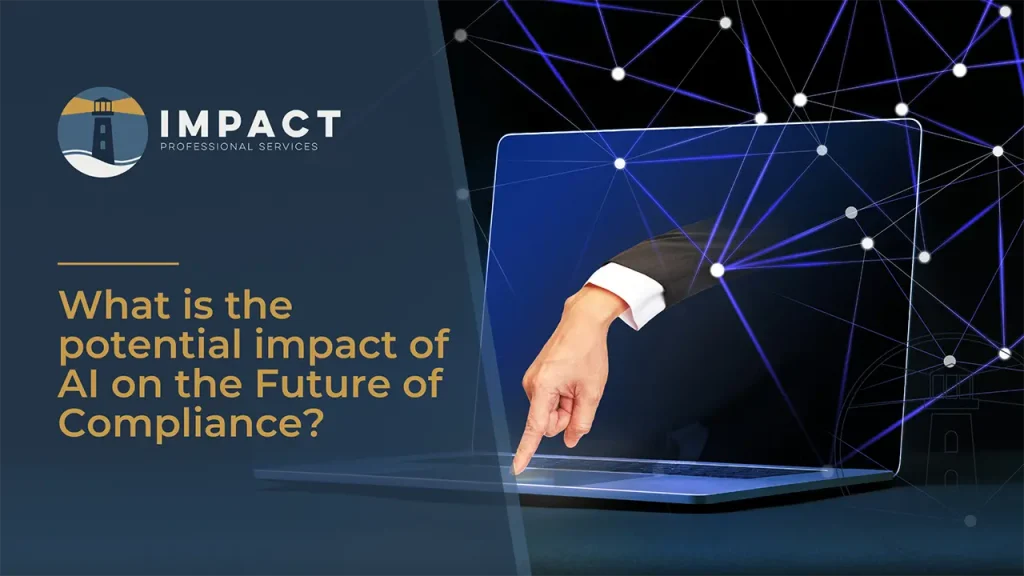
In an increasingly digitised world, the rise of Artificial Intelligence (AI) and Machine Learning (ML) technologies continues to transform industries and professions across the board.
For those at the helm of compliance within organisations, understanding the opportunities and challenges AI presents is crucial.
Impact Professional Services MD, Nick Wait was delighted to catch up with Sinead O’Connor of DQ recently, who shared her personal thoughts on the future of compliance roles amidst the growing influence of AI.
The conversation provided valuable perspectives for compliance professionals and business leaders who will need to navigate these changes.
Embracing AI in the Compliance Landscape
Sinead believes there’s no need for trepidation concerning AI replacing humans in the compliance sector. Compliance is intrinsically a human-centric profession, and the effectiveness of a compliance officer hinges upon their ability to comprehend the needs of the business, anticipate regulatory expectations, and act as a mediator.
These roles capitalize on human insight, intuition, and the capacity to interpret complex issues—traits that AI has yet to master.
Enhancing Knowledge with Technology
The evolution of technology has always sought to ease the cognitive load on professionals by streamlining information acquisition.
In the era predating the internet, mastering compliance was reliant on manual reviews of textual regulation. Today, AI advancements promise to simplify this aspect further.
The development of tools that would allow for more efficient queries on regulatory websites will support faster and more accurate information retrieval. Such tools could potentially lower the barriers for entry into the sector and expedite the training process for compliance professionals.
The Un-replicable Human Element
Despite the remarkable capabilities of AI, it remains questionable whether AI can emulate the nuanced ‘gut-feeling’ that seasoned compliance officers employ.
This instinctive approach often plays a critical role, especially when conducting customer risk assessments. While ticking boxes and following protocols is straightforward, the final judgment call requires a depth of understanding and a sense of the broader picture that AI is yet to replicate.
AI’s Plausibility vs. Accuracy
One of the most striking points Sinéad made is the distinction between AI-generated answers being plausible rather than accurate. AI systems are designed to produce results that seem correct, but without human oversight, these results may not always be reliable.
Future Collaboration between AI and Humans
The conversation highlights that rather than replacing the human touch, AI should be viewed as an accessory that enhances the acumen of compliance professionals.
Practical applications of AI could include alert systems to prevent oversight or automated processes for time-consuming, data-heavy tasks like client money reconciliations.
However, it’s essential that these AI systems work in concert with the expertise of compliance professionals to ensure that nuance and accuracy are not lost.
Conclusion
As the AI revolution continues to unfold, heads of compliance must approach this transformation with both caution and optimism.
Embracing AI holds the potential to enrich the compliance function, allowing professionals to focus on higher-level planning and decision-making. The balance lies in leveraging technology to improve efficiency while upholding the human elements of judgment and interpretation that safeguard the integrity of compliance work.
Sinead’s discussion provides a reassuring outlook: AI in compliance is a tool for empowerment, not a replacement for human expertise. It is an invitation for professionals to adapt and evolve, ensuring that their roles remain indispensable in the technological age.
Key Takeaways for Compliance Professionals
- AI is a valuable tool to streamline and support the compliance function.
- A compliance officer’s role entails a nuanced understanding that AI is not yet equipped to replicate.
- Educational tools powered by AI could make compliance knowledge more accessible.
- AI-generated solutions require human oversight for validation.
- The future of compliance involves a harmonious blend of human expertise and AI support.
Remember, the key to harnessing AI lies not in fear, but in the strategic collaboration of human intelligence with machine learning. Compliance professionals who can navigate this balance will lead the charge in an AI-enhanced regulatory environment.
You can watch the full conversation between Nick Wait and Sinead O’Connor here.

